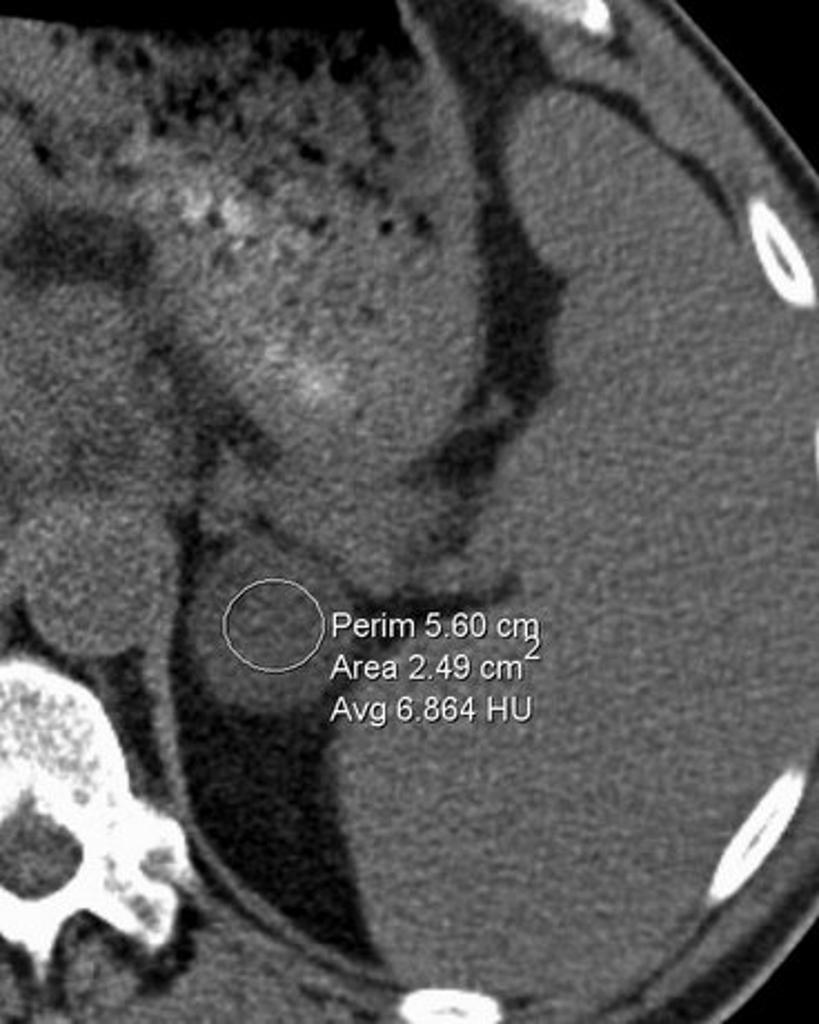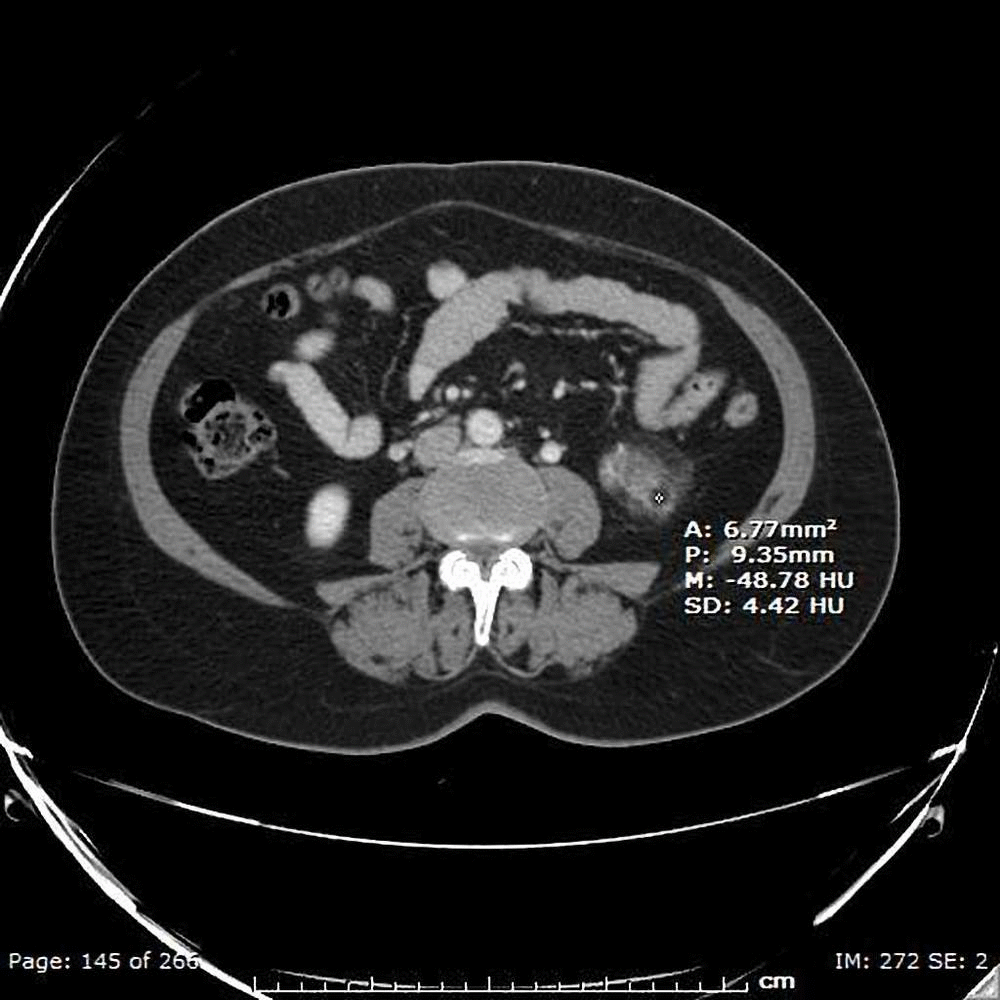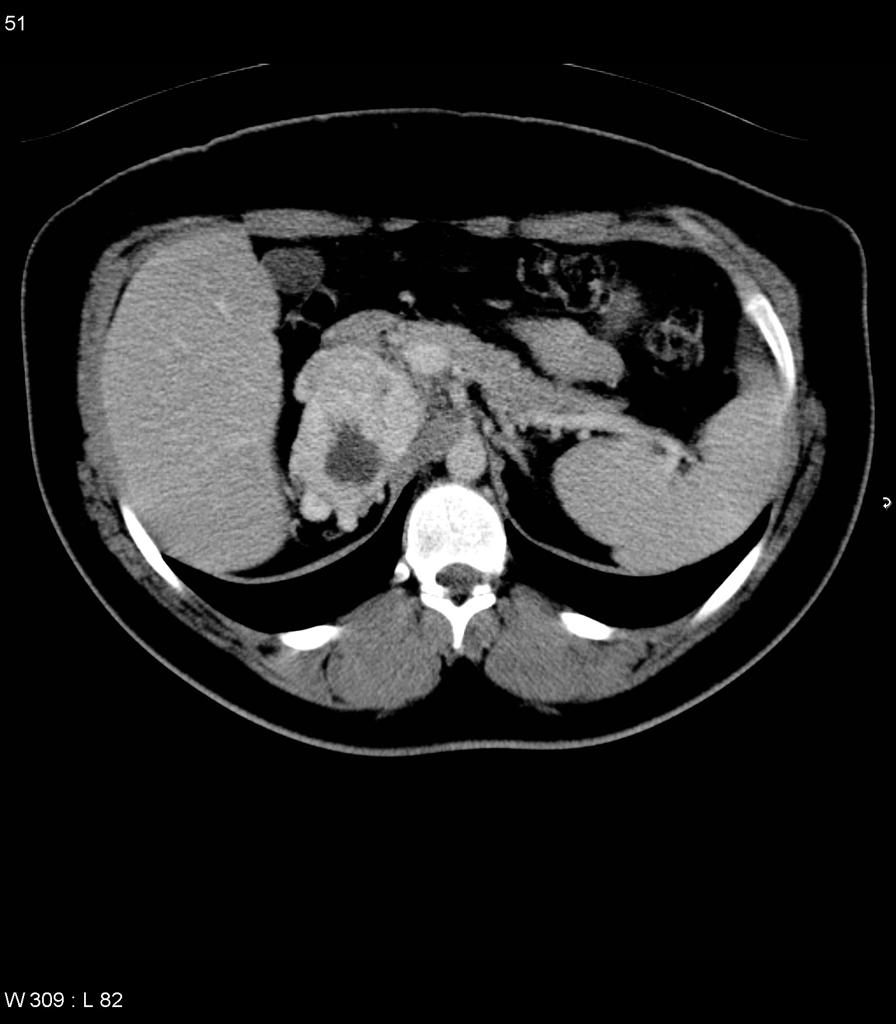Incidentaloma CT scan
|
Incidentaloma Microchapters |
|
Diagnosis |
|---|
|
Treatment |
|
Case Studies |
|
Incidentaloma CT scan On the Web |
|
American Roentgen Ray Society Images of Incidentaloma CT scan |
Editor-In-Chief: C. Michael Gibson, M.S., M.D. [1]; Associate Editor(s)-in-Chief: Mohammed Abdelwahed M.D[2]
Overview
Abdominal CT scan may be helpful in the diagnosis of [disease name]. Differentiation between benign and malignant incidentaloma is important. Malignancy is suggested on CT by a large diameter more than 6 cms, irregular border, inhomogeneity, a “washout” of contrast after 15 min of less than 40%, and calcifications. Contrast-enhanced washout CT utilizes the unique perfusion pattern of adenomas. Adenomas take up intravenous CT contrast rapidly, but also have a rapid loss of contrast – a phenomenon termed ‘contrast enhancement washout’. It is assumed that malignant adrenal lesions usually enhance rapidly but demonstrate a slower washout of contrast medium.
CT scan
- Malignancy is suggested on CT by below features:
- Large diameter more than 6 cm,
- Irregular border,
- Non-homogenous,
- Washout of contrast after 15 min of less than 40%,
- Calcifications.[1]
- Many malignant lesions may look benign.
The Hounsfield unit differentiation
- CT has a high quantitative contrast resolution, which allows assessment of tissue density by measuring X-ray absorption of tissues.
- This allows calculation of tissue attenuation or tissue density values, which are measured in Hounsfield units (HU).
- The Hounsfield unit (HU) is a quantity commonly used in computed tomography (CT) scanning to express CT numbers in a standardized and convenient form.
- Hounsfield units are obtained from a linear transformation of the measured attenuation coefficients.
- The intra-cytoplasmic fat in adenomas results in low attenuation on non-enhanced CT in contrast to non-adenomas have higher attenuation in non-enhanced CT.[2]
- Typical pre-contrast Hounsfield unit (HU) values are as below measures:
- adipose tissue = -20 to -150 HU
- kidney = 20 to 150 HU.
- If an adrenal mass measures <10 HU on un-enhanced CT, the likelihood that it is a benign adenoma is nearly 100 percent.
- A homogeneous adrenal mass with a smooth border and an attenuation value <10 HU on un-enhanced CT is likely to be a benign adenoma.[3]
- The only patients in the non-adenoma groups with a non-contrast CT HU <10 were those with myelo-lipomas.
Contrast-enhanced washout CT
- Contrast-enhanced washout CT utilizes the unique perfusion pattern of adenomas. Adenomas take up intravenous CT contrast rapidly, but also have a rapid loss of contrast – a phenomenon termed ‘contrast enhancement washout’.[4]
- It is assumed that malignant adrenal lesions usually enhance rapidly but demonstrate a slower washout of contrast medium.[5]
- Fifteen minutes after administration of contrast, an absolute contrast medium washout of more than 40 percent was reported to be 100 percent sensitive and specific for adenoma when patients with adenomas were compared with carcinomas, pheochromocytomas, and metastases.[6]



References
- ↑ Boland GW, Blake MA, Hahn PF, Mayo-Smith WW (2008). "Incidental adrenal lesions: principles, techniques, and algorithms for imaging characterization". Radiology. 249 (3): 756–75. doi:10.1148/radiol.2493070976. PMID 19011181.
- ↑ Nieman LK (2010). "Approach to the patient with an adrenal incidentaloma". J Clin Endocrinol Metab. 95 (9): 4106–13. doi:10.1210/jc.2010-0457. PMC 2936073. PMID 20823463.
- ↑ Grumbach MM, Biller BM, Braunstein GD, Campbell KK, Carney JA, Godley PA; et al. (2003). "Management of the clinically inapparent adrenal mass ("incidentaloma")". Ann Intern Med. 138 (5): 424–9. PMID 12614096.
- ↑ Peña CS, Boland GW, Hahn PF, Lee MJ, Mueller PR (2000). "Characterization of indeterminate (lipid-poor) adrenal masses: use of washout characteristics at contrast-enhanced CT". Radiology. 217 (3): 798–802. doi:10.1148/radiology.217.3.r00dc29798. PMID 11110946.
- ↑ Szolar DH, Kammerhuber FH (1998). "Adrenal adenomas and nonadenomas: assessment of washout at delayed contrast-enhanced CT". Radiology. 207 (2): 369–75. doi:10.1148/radiology.207.2.9577483. PMID 9577483.
- ↑ Song JH, Mayo-Smith WW (2014). "Current status of imaging for adrenal gland tumors". Surg Oncol Clin N Am. 23 (4): 847–61. doi:10.1016/j.soc.2014.06.002. PMID 25246052.